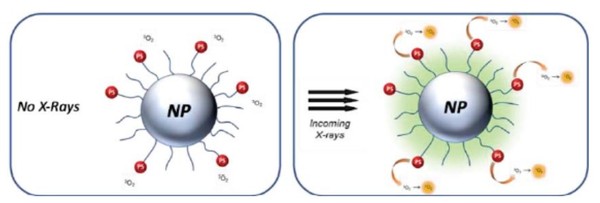X-PDT
X-rays activated Photodynamic Therapy (X-PDT)
Among the strategies for cancer treatment, Photodynamic Therapy (PDT) is a currently clinically used treatment for certain types of cancers (esophagus, lungs). PDT is based on the uptake of a photosensitizer (PS) which, upon excitation by light in a given wavelength, reacts with oxygen and generates reactive oxygen species (ROS - radicals, singlet oxygen), able to kill cancer cells directly and/or damage tumor microvessels. One of the great interest of this technology is that PDT presents reduced long-term morbidity when compared with chemotherapy. However, PDT suffers from a limited use due to the shallow tissue penetration of light and is thus limited when deep tissues are concerned. To overcome that drawback, The SCANnTREAT consortium will design specific nanoprobes capable of generating ROS under low energy X-rays irradiation through a process described as X-rays activated Photodynamic Therapy (figure 2). The proposed methodology uses Low X-rays doses (KeV instead of MeV) to trigger a cascade process leading to the generation of ROS. Thanks to the innovative nanoprobes, X-rays irradiation only becomes the “catalyst”, opening the possibility to treat deep tissues that cannot be reached with classical PDT. Here, the X-ray doses employed will arise from the SPCCT. This will ensure efficiency of the therapy and accuracy of the treatment without damaging the surrounding healthy tissues, leading to faster and better patients’ recovery.

ROS generation by nanoprobe under low X-ray doses


